Abstract
1. It is generally accepted that physical activity provokes changes in the immune system. Previous studies have demonstrated that the stress of physical activity (swimming until exhaustion) increases the phagocytic activity of peritoneal macrophages. However, the precise mechanisms remain unknown. 2. Two experiments were performed in the present study. (A) Peritoneal macrophages from control mice were incubated with plasma from three different groups of mice: (1) mice subjected to swimming until exhaustion with no previous training, (2) mice subjected to the same activity but with 1 month of training (30 min day-1), and (3) a control (non-exercised) group. The differences in the resulting phagocytic (attachment and ingestion) capacity were measured. (B) Changes in the concentration of plasma corticosterone after exercise were also measured, and the effect of incubation with the postexercise plasma corticosterone level on the phagocytic activity of peritoneal macrophages was then studied in vitro. 3. The results were: (A) incubation with plasma from both groups of exercised mice (with and without previous training) led to increased levels of phagocytic capacity (number of C. albicans cells ingested per 100 macrophages). (B) Incubation with a corticosterone concentration of 0.72 mumol l-1 (similar to that observed in plasma immediately after exercise) raised the phagocytic capacity (144 +/- 12 after incubation with 0.72 mumol l-1 vs. 93 +/- 19 after incubation with 0.24 mumol l-1). This increase was also significantly greater than that observed with 7.2 mumol l-1 corticosterone. 4. It is concluded that corticosterone may mediate the increased phagocytic function of peritoneal macrophages induced by exercise.
Full text
PDF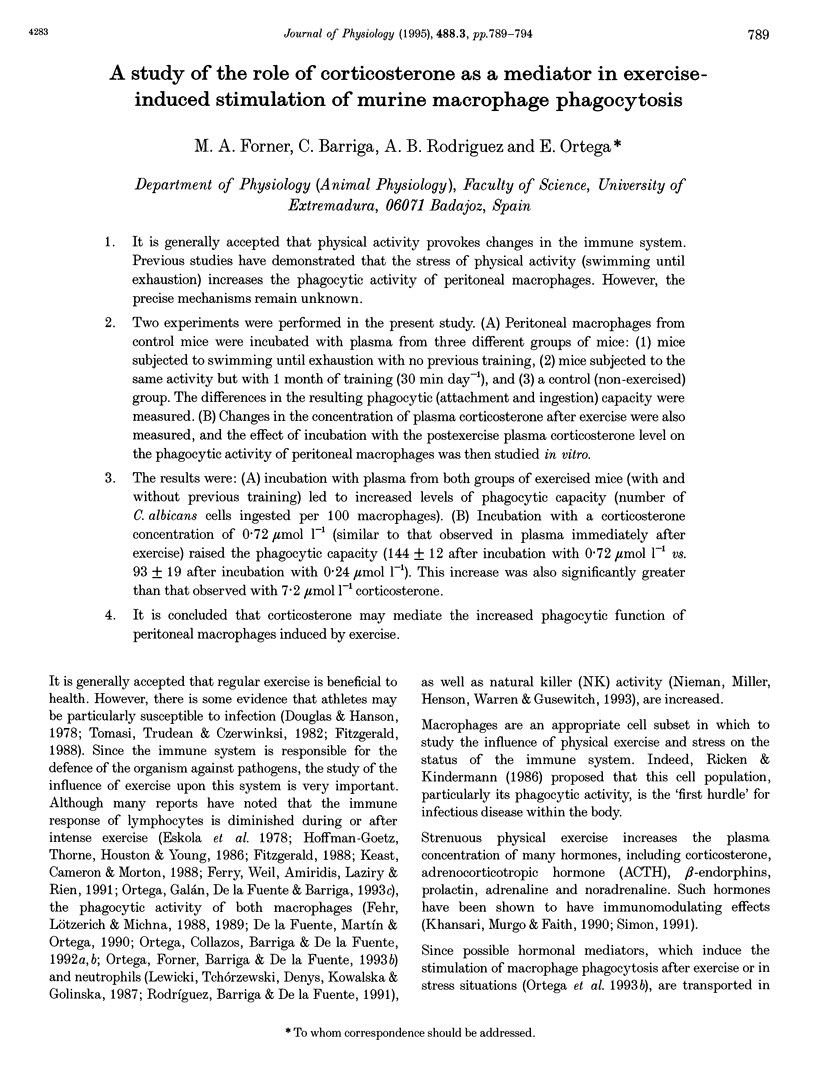
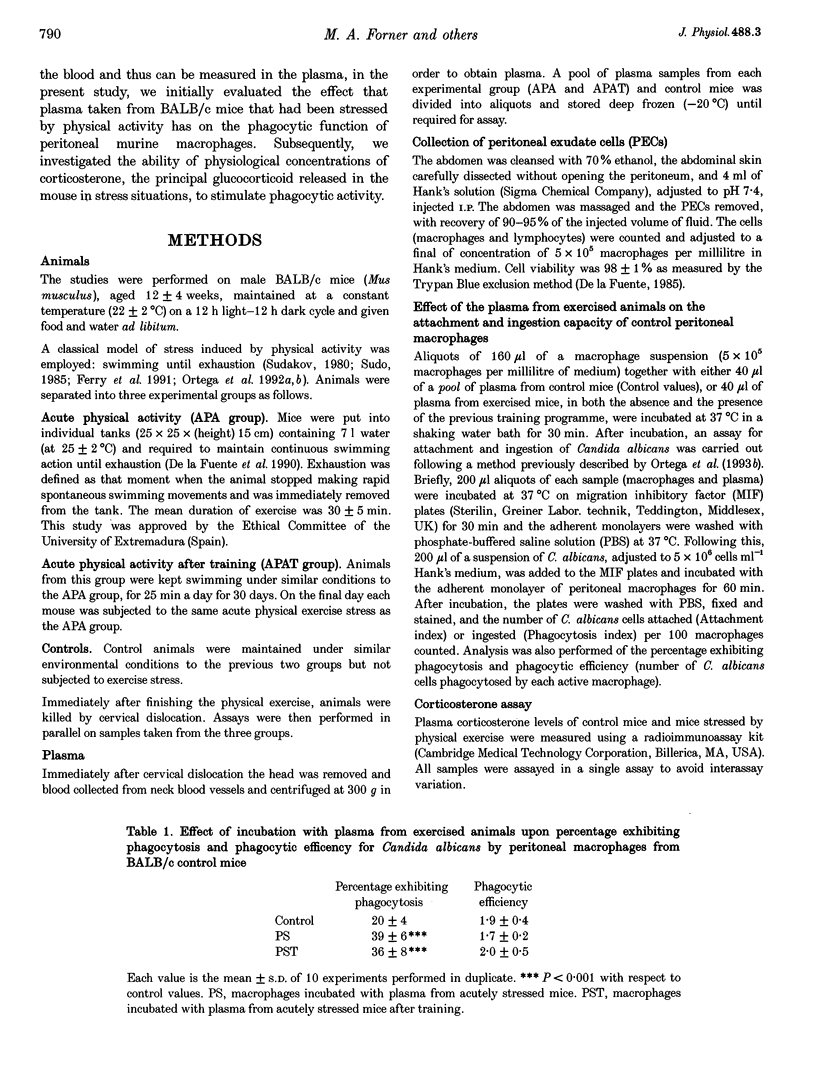
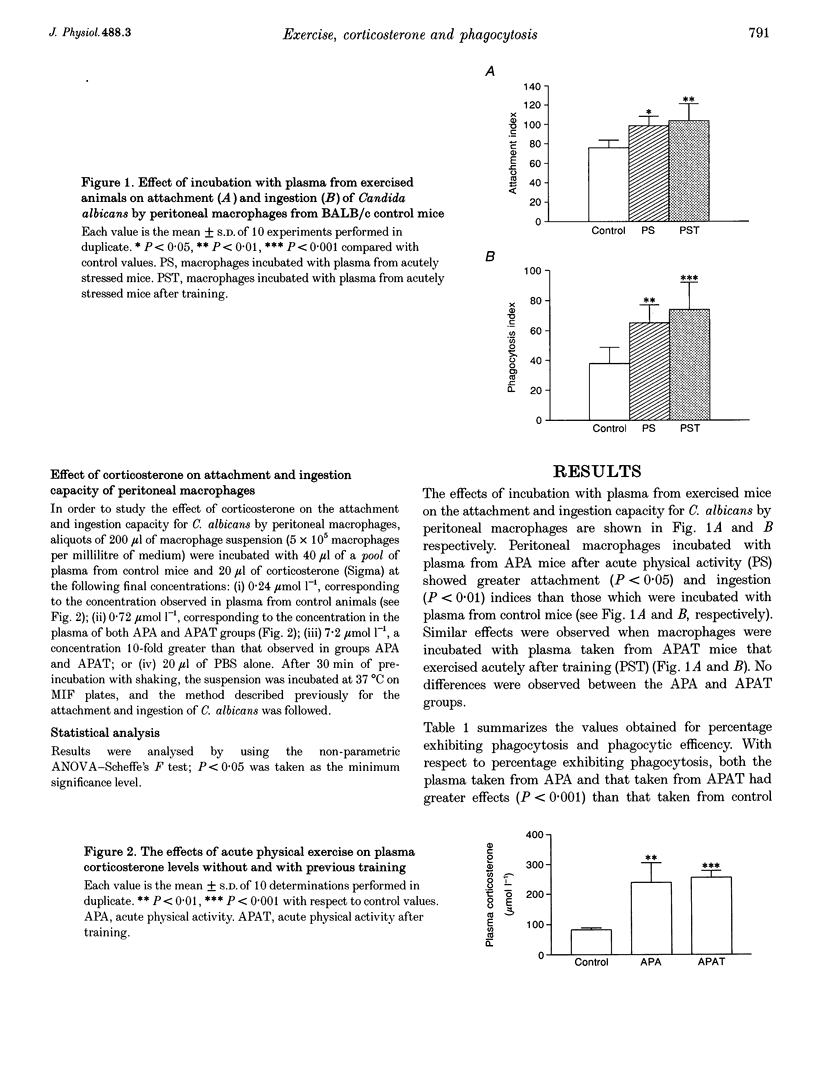
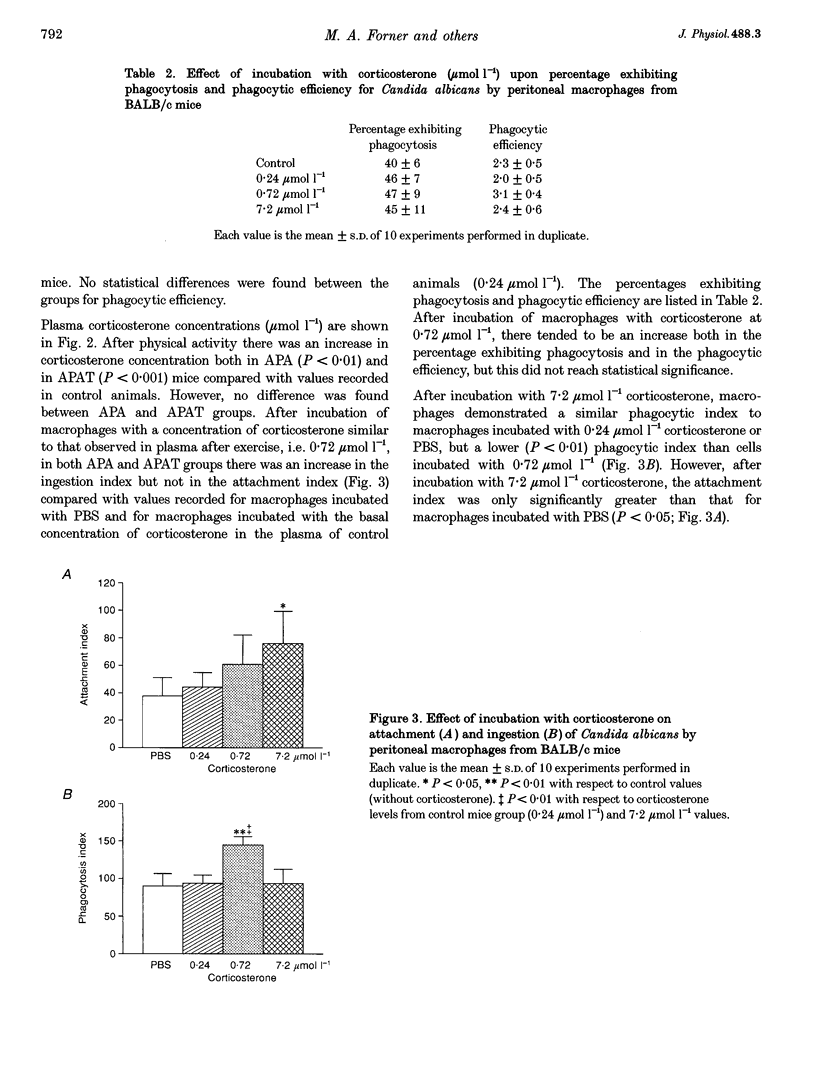
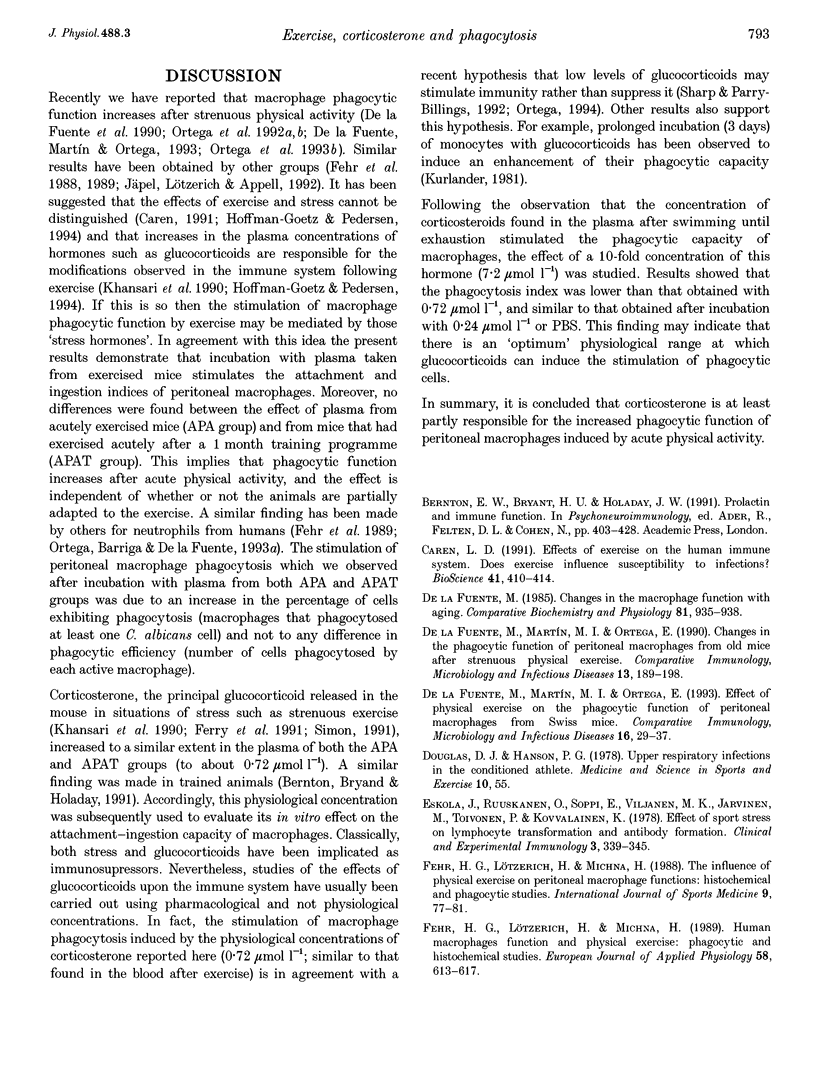
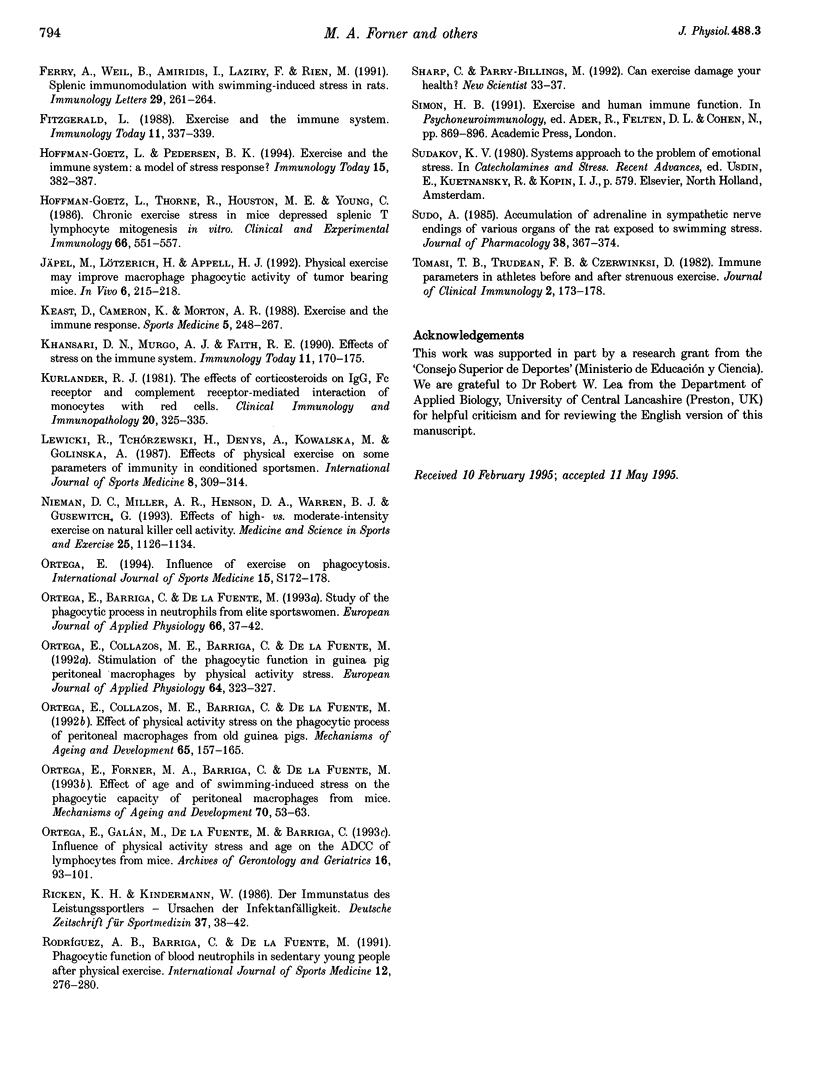
Selected References
These references are in PubMed. This may not be the complete list of references from this article.
- De La Fuente M. Changes in the macrophage function with aging. Comp Biochem Physiol A Comp Physiol. 1985;81(4):935–938. doi: 10.1016/0300-9629(85)90933-8. [DOI] [PubMed] [Google Scholar]
- De la Fuente M., Martín I., Ortega E. Effect of physical exercise on the phagocytic function of peritoneal macrophages from Swiss mice. Comp Immunol Microbiol Infect Dis. 1993 Jan;16(1):29–37. doi: 10.1016/0147-9571(93)90058-d. [DOI] [PubMed] [Google Scholar]
- Eskola J., Ruuskanen O., Soppi E., Viljanen M. K., Järvinen M., Toivonen H., Kouvalainen K. Effect of sport stress on lymphocyte transformation and antibody formation. Clin Exp Immunol. 1978 May;32(2):339–345. [PMC free article] [PubMed] [Google Scholar]
- Fehr H. G., Lötzerich H., Michna H. The influence of physical exercise on peritoneal macrophage functions: histochemical and phagocytic studies. Int J Sports Med. 1988 Feb;9(1):77–81. doi: 10.1055/s-2007-1024983. [DOI] [PubMed] [Google Scholar]
- Ferry A., Weill B., Amiridis I., Laziry F., Rieu M. Splenic immunomodulation with swimming-induced stress in rats. Immunol Lett. 1991 Aug;29(3):261–264. doi: 10.1016/0165-2478(91)90180-i. [DOI] [PubMed] [Google Scholar]
- Fitzgerald L. Exercise and the immune system. Immunol Today. 1988 Nov;9(11):337–339. doi: 10.1016/0167-5699(88)91332-1. [DOI] [PubMed] [Google Scholar]
- Hoffman-Goetz L., Keir R., Thorne R., Houston M. E., Young C. Chronic exercise stress in mice depresses splenic T lymphocyte mitogenesis in vitro. Clin Exp Immunol. 1986 Dec;66(3):551–557. [PMC free article] [PubMed] [Google Scholar]
- Hoffman-Goetz L., Pedersen B. K. Exercise and the immune system: a model of the stress response? Immunol Today. 1994 Aug;15(8):382–387. doi: 10.1016/0167-5699(94)90177-5. [DOI] [PubMed] [Google Scholar]
- Jäpel M., Lötzerich H., Appell H. J. Physical exercise may improve macrophage phagocytic activity of tumor bearing mice. In Vivo. 1992 Mar-Apr;6(2):215–218. [PubMed] [Google Scholar]
- Keast D., Cameron K., Morton A. R. Exercise and the immune response. Sports Med. 1988 Apr;5(4):248–267. doi: 10.2165/00007256-198805040-00004. [DOI] [PubMed] [Google Scholar]
- Khansari D. N., Murgo A. J., Faith R. E. Effects of stress on the immune system. Immunol Today. 1990 May;11(5):170–175. doi: 10.1016/0167-5699(90)90069-l. [DOI] [PubMed] [Google Scholar]
- Kurlander R. J. The effects of corticosteroids on IgG Fc receptor and complement receptor-mediated interaction of monocytes with red cells. Clin Immunol Immunopathol. 1981 Sep;20(3):325–335. doi: 10.1016/0090-1229(81)90143-4. [DOI] [PubMed] [Google Scholar]
- Lewicki R., Tchórzewski H., Denys A., Kowalska M., Golińska A. Effect of physical exercise on some parameters of immunity in conditioned sportsmen. Int J Sports Med. 1987 Oct;8(5):309–314. doi: 10.1055/s-2008-1025675. [DOI] [PubMed] [Google Scholar]
- Nieman D. C., Miller A. R., Henson D. A., Warren B. J., Gusewitch G., Johnson R. L., Davis J. M., Butterworth D. E., Nehlsen-Cannarella S. L. Effects of high- vs moderate-intensity exercise on natural killer cell activity. Med Sci Sports Exerc. 1993 Oct;25(10):1126–1134. [PubMed] [Google Scholar]
- Ortega E., Barriga C., De la Fuente M. Study of the phagocytic process in neutrophils from elite sportswomen. Eur J Appl Physiol Occup Physiol. 1993;66(1):37–42. doi: 10.1007/BF00863397. [DOI] [PubMed] [Google Scholar]
- Ortega E., Collazos M. E., Barriga C., De la Fuente M. Effect of physical activity stress on the phagocytic process of peritoneal macrophages from old guinea pigs. Mech Ageing Dev. 1992 Sep;65(2-3):157–165. doi: 10.1016/0047-6374(92)90032-9. [DOI] [PubMed] [Google Scholar]
- Ortega E., Collazos M. E., Barriga C., De la Fuente M. Stimulation of the phagocytic function in guinea pig peritoneal macrophages by physical activity stress. Eur J Appl Physiol Occup Physiol. 1992;64(4):323–327. doi: 10.1007/BF00636219. [DOI] [PubMed] [Google Scholar]
- Ortega E., Forner M. A., Barriga C., De la Fuente M. Effect of age and of swimming-induced stress on the phagocytic capacity of peritoneal macrophages from mice. Mech Ageing Dev. 1993 Aug 1;70(1-2):53–63. doi: 10.1016/0047-6374(93)90059-z. [DOI] [PubMed] [Google Scholar]
- Ortega E., Galán M., De La Fuente M., Barriga C. Influence of physical activity stress and age on the ADCC of lymphocytes from mice. Arch Gerontol Geriatr. 1993 Jan-Feb;16(1):93–101. doi: 10.1016/0167-4943(93)90030-l. [DOI] [PubMed] [Google Scholar]
- Rodriguez A. B., Barriga C., De la Fuente M. Phagocytic function of blood neutrophils in sedentary young people after physical exercise. Int J Sports Med. 1991 Jun;12(3):276–280. doi: 10.1055/s-2007-1024680. [DOI] [PubMed] [Google Scholar]
- Sudo A. Accumulation of adrenaline in sympathetic nerve endings in various organs of the rat exposed to swimming stress. Jpn J Pharmacol. 1985 Aug;38(4):367–374. doi: 10.1254/jjp.38.367. [DOI] [PubMed] [Google Scholar]
- Tomasi T. B., Trudeau F. B., Czerwinski D., Erredge S. Immune parameters in athletes before and after strenuous exercise. J Clin Immunol. 1982 Jul;2(3):173–178. doi: 10.1007/BF00915219. [DOI] [PubMed] [Google Scholar]
- de la Fuente M., Martin M. I., Ortega E. Changes in the phagocytic function of peritoneal macrophages from old mice after strenuous physical exercise. Comp Immunol Microbiol Infect Dis. 1990;13(4):189–198. doi: 10.1016/0147-9571(90)90087-a. [DOI] [PubMed] [Google Scholar]


